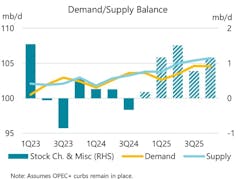IEA: Oil market to face sizeable surplus next year
The International Energy Agency (IEA) projected in its October Oil Market Monthly Report that, with weak demand growth and continued supply gains, the oil market will face a sizable surplus in the new year unless a major supply disruption occurs.
Global oil demand is expected to increase by just under 900,000 b/d in 2024 and by around 1 million b/d in 2025, marking a sharp slowdown from the 2 million b/d growth seen during the 2022-2023 post-pandemic period.
“Global oil demand rose by 680,000 b/d y-o-y in third-quarter 2024, lower than expected and at its slowest pace since fourth-quarter 2022 when China’s economy was in full lockdown. Accordingly, we see muted global demand growth of 860,000 b/d on average in 2024, down by 40,000 b/d from last month’s report,” IEA said.
Chinese oil demand remains below expectations, significantly affecting overall growth. China's contribution is expected to account for about 20% of global growth in 2024 and 2025, compared with nearly 70% in 2023, according to IEA.
“Following a surge of 1.4 million b/d in 2023, when the country emerged from stringent public health restrictions, growth is forecast to contract sharply this year on an annual basis, to a projected 150,000 b/d. Moreover, this slowdown shifted into an outright downturn in both second-quarter 2024 and third-quarter 2024. This culminated in a 500,000 b/d annual contraction in August,” IEA said.
IEA expects a return to modest growth during the final quarter of the year and in 2025, when China’s annual demand will increase by 220,000 b/d.
“Recently announced government stimulus packages for the economy are expected to support the resumption of an upward trajectory, but the overall impact is likely to be limited and we anticipate any increase in oil demand will be overwhelmingly dependent on growth in petrochemical feedstock products,” IEA added.
Global oil supply
Global oil supply plunged by 640,000 b/d in September to 102.8 million b/d, as Libya’s political quagmire disrupted the country’s oil production and exports, and as field maintenance work in Kazakhstan, Norway, and Canada lowered output.
In early October, benchmark oil prices surged as escalating tensions between Israel and Iran raise fears of a broader Middle East conflict affecting Iranian exports. However, the resolution of Libya's political dispute, only modest production losses from hurricanes in the US Gulf Coast, and weak end-user demand have helped stabilize the markets.
Barring any further unplanned disruptions, global oil supply growth is forecast to increase by 660,000 b/d to 102.9 million b/d in 2024, slightly lower than last month’s report. Assuming extra voluntary OPEC+ curbs are maintained, IEA forecasts global oil supply to rise by 2 million b/d in 2025 to 105 million b/d.
Non-OPEC+ output, led by the Americas, is expected to expand by 1.5 million b/d in 2024, according to IEA. For 2024 as a whole, US output is forecast to rise by 630,000 b/d to 20.1 million b/d on average, with crude accounting for 270,000 b/d and NGLs for 360,000 b/d of the increase. Next year will see additional gains of 630,000 b/d, lifting total oil supplies to 20.8 million b/d. US crude production will increase by 390,000 b/d while NGL growth slows to 250,000 b/d.
On Oct. 2, OPEC+’s top ministers decided to maintain the current oil output policy, which includes increasing output from December, while highlighting the need for some members to make additional cuts to offset overproduction. The OPEC+ alliance will see production contract by 820,000 b/d in 2024, according to IEA.
Refining, inventories
Refining margins slumped further in September as gasoline, jet and diesel cracks deteriorated while crude prices improved on a relatively tighter market. Consequently, IEA's revised global crude run estimates have been reduced by 180,000 b/d to 82.8 million b/d for 2024 and by 210,000 b/d to 83.4 million b/d in 2025. These still reflect annual gains of 540,000 b/d and 610,000 b/d, respectively.
Observed global oil inventories declined by 22.3 million bbl in August, led by a 16.5 million bbl draw in crude oil stocks. OECD industry stocks fell counter-seasonally by 13.4 million bbl to 2,811 million bbl, 102.7 million bbl below the 5-year average. Preliminary data suggest oil stocks fell further in September. Relatively robust refining activity and OPEC+ supply cuts have underpinned a 135 million bbl draw in crude stocks since May, while product stocks built by 35 million bbl over the same period.
